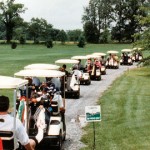For golfers over the age of 50, golf flexibility is important for a fluid powerful golf swing and as well as for a continuously satisfying game of golf, staying fit and healthy, and keeping up vital social connections. Poor golf flexibility can result to an inconsistent game with poor accuracy including inconsistent contact with the golf ball or, at worst, physical injury.
As we age, our body becomes stiffer and will result to poor golf mechanics. It is important to keep our bodies flexible to keep the correct position required for a sound powerful golf swing.
Physical stiffness can result in game problems ranging from excessive head movement, body swaying, a flying elbow, physical injury, and inconsistent ball hitting. Moreover, these faults are exceptionally difficult to correct without first improving personal physical flexibility.
1. Consistency in Golf
Golf flexibility is very closely linked to golf consistency. This is why it is of number one priority to work on your flexibility.
Head Movement
Very often golfers over the age of 50 lose flexibility and their ability to rotate their head to the side due to increased neck stiffness. It is vital that you can rotate your head 70 degrees to the left if you are a right-handed golfer.
You may be asking how this relates to golf consistency. When an older golfer is taking his or her back swing, their shoulders are rotating off to the right while the head needs to be relatively still. Stillness is important so the golfers could keep their eyes focused on the ball. For golfers who suffer with neck stiffness, their head will be forced to rotate along with the shoulders, thus moving the head and eyes along at the same time with the shoulders, instead of staying still for ball focus.
To keep a steady eye on the ball you must keep your head stable and this call for flexibility.

Swing Center Movement Factor
Good spinal flexibility is important to master the swing center movement factor. Golfers who have poor posture where the spine is C-shaped or S-shaped will find that the spine is no longer able to purely rotate in the back swing without their body moving up and down and/or to the side. It will be like trying to hit a moving golf ball and nearly impossible to hit that golf ball consistently and accurately.
Golf flexibility will help you to regain and keep pure spinal rotation.
Correct Weight Shifting
Lastly and by far not the least, good hip flexibility is crucial for correct weight distribution, critical for consistency in your game. During the back swing, it is important you rotate your body to the right against a stable right leg. Preferably your right knee should retain its bend. The kneecap should have minimal rotation and your body weight will stay over the inside of your right foot. For this to happen, your right hip should have at least 35 degrees of internal rotation.
2. Golf Power
The loss of golf power is a major problem and distressing for many golfers over 50. How much more fun to hit the much easier short irons and the more difficult hybrids into the greens! With good flexibility, you hit a lot more greens, pot more birdies, and your scores become scores to be proud of.
“Scientific research has shown that most power losses are completely preventable and are directly related to flexibility, especially to those golfers under the age of 75.”
So, the question is, what can you do to increase your golf power substantially?
The X-Factor
First off, improving specific golf flexibility will improve your “X-factor”. This factor is the difference between your hip rotation and spinal rotation. This means for example, when the golfer is about to hit the golf ball, players with a good X-factor will already have their bodies squarely facing the target. This is a crucial key to effortless swing power.
A poor X-factor means you may swing as hard as you want but you are not going to add much distance because of the lack of flexibility problem. The more you neglect flexibility, the worse the issue will become.
Swing Width
Putting it simply, improved golf flexibility will result in an improved swing width. Swing width is how far the club and your hands are away from your point of center of movement. The point of your center of movement is the point just below the center of your chest. The further away from the center of movement, the faster the head of the club will travel.
Because professional golfers have good flexibility, they can get full back swing while keeping the left elbow straight. Golfers who suffer poor flexibility tend to sacrifice their power in a couple of ways. In order to get a full back swing, they may allow their elbows to collapse or they may keep their width with a straight left elbow which significantly shortens the back swing.

3. Golf Accuracy
Golfers with poor flexibility lose accuracy and this is directly related back to the “X-factor”. To explain a little, initially, when Jim McLean came up with the term “X-factor”, it was the difference between the rotation of the hips and shoulders measured at the top of the back swing. This is no longer relevant. The new X- factor is the difference between hip and shoulder rotation directly at the point of impact with the golf ball and is much more critical for power.
The New X-Factor and the Transition Move
In order to make the most of the new X-factor, you must master the transition move. The transition move is the first move you make back towards the golf ball from your position at the top of the back swing. Typically the first move is made with the hips rotating forwards, and this will be easier to achieve with practice if you focus on the left knee sliding towards the target.
Stiff older golfers who lack flexibility are unable to rotate their hips separately from the upper body and this is where accuracy is sacrificed. The stiffer older golfer will not be able to swing the club down from the inside the target line because the hips cannot rotate before the shoulders. Thus the golfer will swing from the “outside to in” of the swing plane, resulting in the over-the-top swing. As the swing plane is so much steeper, this will result in pulls, slices, and generally makes it more difficult to make clean and accurate contact with the ball.

So Let’s Get Going And Be Flexible!
Flexibility is not an option, though we may think it is… If you want to continue playing satisfying and enjoyable games of golf, keep fit, well, and healthy and enjoy your social life after the age of 50. Flexibility is a must.
Flexibility can be worked on anywhere. You can do little stretching exercises when you first wake up in the morning as you lie in bed, while standing in line at the bank or even while watching TV. It’s very much a choice we make. Flexibility requires consistency and constancy. Team up with a buddy and work out a program which will benefit you both to stay fit, healthy, and well and to keep on playing an Age Defying Game of Golf.

 Taking It to the Course
Taking It to the Course Your Best Teacher
Your Best Teacher Why a Pre-Shot Routine is Essential for your Golf Game
Why a Pre-Shot Routine is Essential for your Golf Game Hit the Ball Straighter with the Towel Drill
Hit the Ball Straighter with the Towel Drill 5 Major Flaws With Your Clubs That’s Hurting Your Game
5 Major Flaws With Your Clubs That’s Hurting Your Game GOLF HUMOR: All For The Love of the Game
GOLF HUMOR: All For The Love of the Game